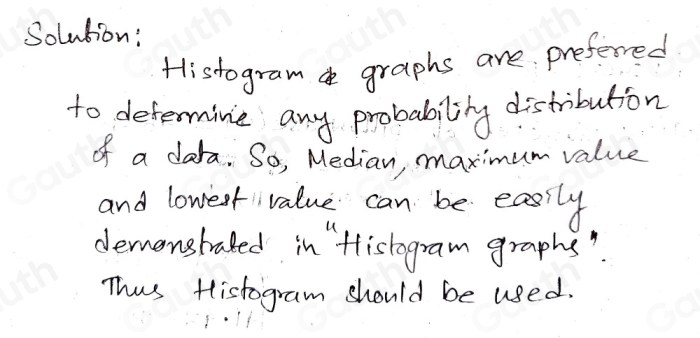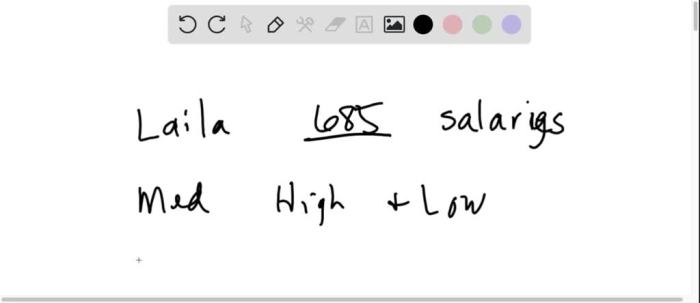Laila wants to create a data display – Embarking on Laila’s quest to create a captivating data display, we delve into the realm of data visualization, where raw information transforms into compelling narratives. Laila’s project presents an exciting opportunity to explore the intricacies of data collection, visualization, interactivity, and storytelling, promising a visually stunning and insightful experience.
As we navigate the complexities of data handling, we’ll uncover the techniques for gathering and organizing relevant data, ensuring its accuracy and usability. Laila’s vision for an interactive display will lead us to examine the benefits and tools for creating engaging visualizations that empower users to explore data in dynamic ways.
Data Collection and Preparation
Laila’s project requires the collection of relevant data. This can be done through various methods, including:
- Surveys: Online or offline questionnaires to gather data from a specific population.
- Interviews: Conducting one-on-one or group discussions to obtain qualitative insights.
- Focus groups: Bringing together a small group of participants for moderated discussions.
- Data mining: Extracting data from existing sources, such as company databases or publicly available datasets.
Potential data sources for Laila include:
- Customer feedback: Gathering feedback from existing customers through surveys or interviews.
- Market research: Conducting surveys or focus groups to understand market trends and preferences.
- Social media data: Analyzing data from social media platforms to gauge public sentiment or identify patterns.
- Internal company data: Utilizing existing data from sales, marketing, or customer service systems.
Once the data is collected, it should be cleaned and organized to ensure its accuracy and usability. This involves removing duplicates, correcting errors, and formatting the data consistently.
Data Visualization: Laila Wants To Create A Data Display

Data visualization is essential for presenting data in a clear and engaging manner. Laila can choose from various types of visualizations, including:
- Charts: Bar charts, line charts, and pie charts are commonly used to display data in a visual format.
- Graphs: Scatterplots and histograms help identify relationships and distributions within data.
- Maps: Geographic visualizations can display data on a map, making it easier to see spatial relationships.
- Infographics: A combination of visual elements, such as charts, graphs, and text, to present complex data in an easy-to-understand format.
When choosing a visualization, Laila should consider the following principles:
- Clarity: The visualization should be easy to understand and interpret.
- Accuracy: The visualization should accurately represent the data.
- Relevance: The visualization should be relevant to the audience and the message being conveyed.
Interactive Data Displays

Interactive data displays allow users to explore and interact with the data. Examples include:
- Dashboards: Customizable dashboards provide a comprehensive view of key metrics and allow users to drill down into specific areas.
- Interactive maps: Users can zoom, pan, and filter data on a map to gain insights into geographic relationships.
- Data exploration tools: Tools that allow users to filter, sort, and manipulate data to identify patterns and trends.
Interactive visualizations offer several benefits:
- Enhanced engagement: Users are more likely to engage with and explore interactive visualizations.
- Improved understanding: Interactive visualizations allow users to gain a deeper understanding of the data by exploring it from different perspectives.
- Actionable insights: Interactive visualizations can help users identify actionable insights that can drive decision-making.
Data Storytelling

Data storytelling is the art of communicating insights from data in a compelling and persuasive manner. Laila should:
- Identify the story: Determine the key message or insight that the data reveals.
- Craft a narrative: Create a logical flow of information that leads the audience through the story.
- Use visuals effectively: Incorporate data visualizations to support and illustrate the narrative.
- Engage the audience: Use language and visuals that resonate with the target audience.
Design Considerations

The design of data displays is crucial for effective communication. Laila should consider the following principles:
- Color: Use colors strategically to highlight important data and create visual hierarchy.
- Typography: Choose fonts that are easy to read and visually appealing.
- Layout: Arrange elements in a logical and visually pleasing manner, ensuring that the display is easy to navigate.
Examples of well-designed data displays include:
- The New York Times’ interactive election map: https://www.nytimes.com/interactive/2020/11/03/us/elections/results-map.html
- Google’s Data Studio: https://datastudio.google.com/
- Tableau Public: https://public.tableau.com/
Key Questions Answered
What is the purpose of Laila’s data display?
Laila aims to create a visually appealing and informative data display that effectively communicates insights and engages the audience.
What types of data visualizations will Laila explore?
Laila will consider various data visualization techniques, including charts, graphs, maps, and interactive dashboards, to suit the specific data and audience.
How will Laila ensure the accuracy and reliability of her data?
Laila will employ data cleaning and organization techniques to ensure the accuracy and consistency of her data, drawing from reputable sources and verifying information.
